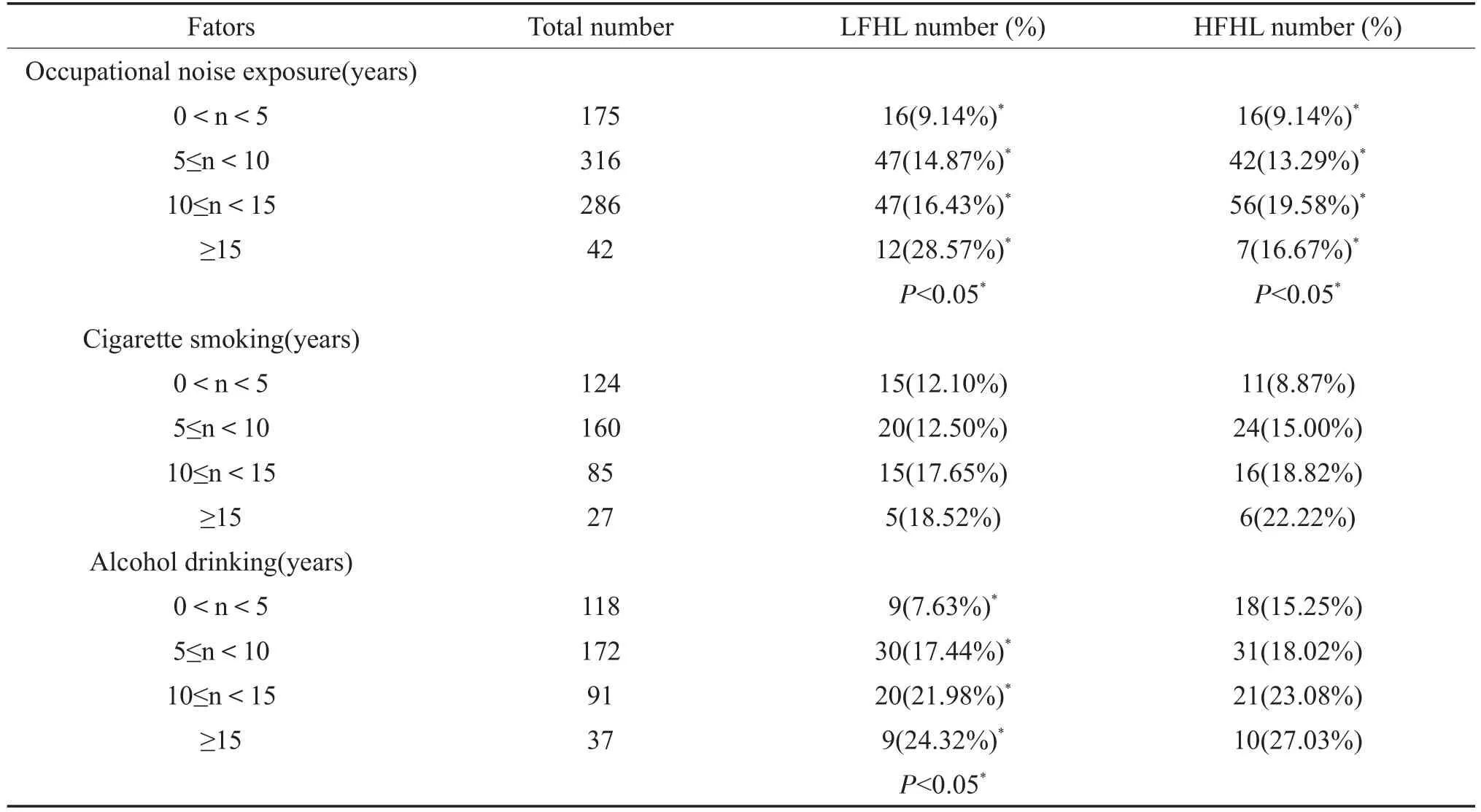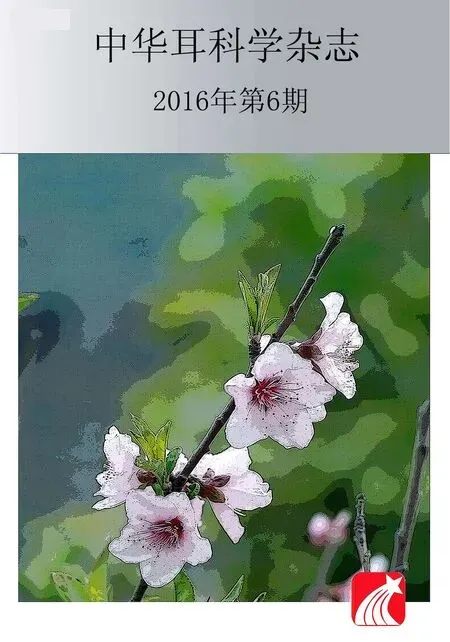吸烟和饮酒对职业性噪声暴露对工人听力的影响
郭洋 孙渊渊 王慧 冯艳梅 时海波 殷善开
上海交通大学附属第六人民医院耳鼻咽喉头颈外科(上海200233)
上海交通大学耳鼻咽喉科研究所(上海200233)
·噪声性聋专辑·
吸烟和饮酒对职业性噪声暴露对工人听力的影响
郭洋 孙渊渊 王慧 冯艳梅 时海波 殷善开
上海交通大学附属第六人民医院耳鼻咽喉头颈外科(上海200233)
上海交通大学耳鼻咽喉科研究所(上海200233)
目的探讨吸烟、饮酒、职业性噪声暴露对工人听力的影响。方法选取某重型装备制造厂中噪声暴露环境下工人作为研究对象,问卷调查其噪声暴露史、吸烟史、饮酒史等,并在隔音室内进行纯音测听检查,将PTA0.25-3>25dB HL记为低频听力损失,PTA4-8>40dB HL记为高频听力损失。根据吸烟史、饮酒史将受试者分为不吸烟不饮酒组(C0A0)、吸烟不饮酒组(C1A0)、饮酒不吸烟组(C0A1)、吸烟饮酒组(C1A1),以不吸烟不饮酒组(C0A0)为对照组统计分析各组听力情况的区别。并应用Logistic回归分析吸烟、饮酒、噪声的不同暴露时间(0-5年、5-10年、10-15年、≥15年)对听力的影响。结果C1A0、C0A1、C1A1各组中听力损失工人的听力阈值及各组听力损失率与C0A0组的差异无统计学意义。Logistic回归分析显示相对于噪声暴露0-5年的工人,噪声暴露5-10年、10-15年、≥15年的工人发生低频听力损失的优势比分别为1.736、1.954、3.975,发生高频听力损失的优势比分别为1.517、2.257、1.627;相对于不饮酒人群,不同饮酒时间工人发生高频听力损失的优势比为1.777、1.814、2.402、3.134。结论饮酒可能会增加噪声暴露下工人听力受损的危险性,应在加强工人个人防护的基础上劝诫工人养成良好的生活习惯;而吸烟可能并不是造成听力损失的主要危险因素。
噪声;吸烟;饮酒;听力损失
This work was supported by grants from the National Natural Science Foundation of China(No.81530029 and No.81300820)
Declaration of interest:The authors declare no confict of interest.
随着社会经济以及工业的不断发展,职业性噪声暴露成为了导致听力损失的最主要噪声来源,全世界越来越多的劳动者的作业环境被职业性噪声污染[1,2]。职业噪声暴露导致的噪声性听力损失(noise-induced hearing loss,NIHL)是我国乃至世界上最主要的职业病危害之一。本文通过回顾性队列研究,在噪声暴露人群中探讨职业性噪声暴露以及吸烟、饮酒与听力损失之间的关系。
1 对象和方法
1.1 研究对象
对上海市某重型装备制造厂连续性噪声环境下的作业工人1872人进行听力学检查,研究对象的纳入标准为:①年龄低于40岁;②男性工人;③外耳道及鼓膜正常;④中耳鼓室图为A型。排除标准为:①既往有耳毒性药物应用史;②外耳道或鼓膜异常者;③耳聋家族史者;④中耳功能异常者;⑤颅脑外伤史者。最终819人入选,平均年龄为31.77±5.07岁,平均噪声暴露时间为8.02±3.96年,其中电焊工339人、冷作工408人、其他工种72人,8h等效噪声声级dB(A)分别为81.0、80.1、81.4 dB(A)。根据各位受试者吸烟(Cigarette Smoking)、饮酒(Alcohol Consumption)经历分为不吸烟不饮酒组(C0A0)257人、吸烟不饮酒组(C1A0)135人、饮酒不吸烟组(C0A1)166人、吸烟饮酒组(C1A1)261人。并将受试者根据各因素的暴露时间分别分为0-5年、5-10年、10-15年、≥15年四组。纳入吸烟组别的标准为:平均每天抽烟≥1支;纳入饮酒组别的标准为:平均每周饮酒≥1次。
1.2 方法
1.2.1 问卷调查
问卷调查内容:询问受试者一般情况、个人史、家族史、工种、噪声环境工作史、耳毒性药物应用史、吸烟史、饮酒史以及中耳炎、颅脑外伤史等。在研究人员指导下,工人在规定时间内填写问卷答案以减少回忆偏倚。为减少调查偏倚,参与问卷调查的研究人员均经过统一培训并均通过了测试评估。
1.2.2 外耳道及中耳检查
用耳镜检查受试者的外耳道情况,并用中耳分析仪检测受试者中耳功能。
1.2.3 纯音听阈测试
在本底噪声<30dB(A)隔音室中,采用丹麦尔听美公司科丽纳™Conera™纯音测试仪,测试并记录0.25、0.5、1、2、3、4、6、8kHz的纯音听阈值。计算听力较好侧耳0.25、0.5、1、2、3kHz的平均听阈为PTA0.25-3,4、6、8kHz的平均听阈为PTA4-8。参照Gopi⁃nath B等的标准,将PTA0.25-3>25dB HL记为低频听力损失(low-frequency hearing loss,LFHL),PTA4-8>40dB HL记为高频听力损失(high-frequency hearing loss,HFHL)[3],以此计算各组的听力损失人数及听力损失率,其中听力损失率(%)=听力损失人数/此组总人数。
1.3 统计学方法
采用Excel软件录入数据建立数据库,利用SPSS19.0软件进行统计学分析。计量资料对比采用单因素方差分析、计数资料对比采用卡方检验,以P<0.05为差异有统计学意义。采用Logistic回归分析探讨职业性噪声、吸烟及饮酒的暴露时间对工人听力损失的影响。
2 结果
2.1 不同吸烟饮酒史组别工人的听力阈值及听力损失率
如表1所示,各组噪声暴露时间经ANOVA统计学分析表明,四组间噪声暴露时间中C1A0组略低于C0A1、C1A1组(P<0.05),而其他各组之间的噪声暴露时间差异无统计学意义(P>0.05)。

表1 工人噪声暴露时间(n=819)Table1 Occupational noise exposure time of the workers(n=819)
表2为噪声暴露工人低频听力损失(PTA0.25-3>25dBHL)一般情况,四组PTA0.25-3差异无统计学意义(F=0.635,P=0.593)。C1A0组、C0A1组、C1A1组低频听力损失率与C0A0组相比差异无统计学意义(χ2=1.747,P=0.186;χ2=0.217,P=0.642;χ2=0.407,P= 0.524)。

表2 噪声暴露工人低频听力损失(PTA0.25-3>25dBHL)情况(n=819)Table 2 Low-frequency hearing loss(PTA0.25-3>25dBHL)of the occupational noise exposed workers(n=819)
表3为噪声暴露工人高频听力损失(PTA4-8>40dBHL)一般情况,四组PTA4-8差异无统计学意义(F=0.20,P=0.895),C1A0组、C0A1组、C1A1组高频听力损失率与C0A0组相比差异无统计学意义(χ2= 2.675,P=0.102;χ2=2.673,P=0.102;χ2=3.422,P=0.064)。

表3 噪声暴露工人高频听力损失(PTA4-8>40dBHL)情况(n=819)Table 3 High-frequency hearing loss(PTA4-8>40dBHL)of the occupational noise exposed workers(n=819)
2.2 不同吸烟时间、饮酒时间、噪声暴露时间对听力的影响
不同吸烟时间、饮酒时间、噪声暴露时间对工人的低频听力、高频听力的影响如表4所示。经卡方检验分析表明,不同噪声暴露时间组的低频听力损失率差异有统计学意义(χ2=11.298,P=0.01),高频听力损失率差异有统计学意义(χ2=10.326,P=0.016)。吸烟人群中,低频听力损失率(χ2=2.079,P=0.556)与高频听力损失率(χ2=5.814,P=0.121)虽然有随吸烟时间的增加逐渐增加的趋势,但不同吸烟年限之间听力损失率差异并无统计学意义。饮酒人群中,不同饮酒年限组别的低频听力损失率差异有统计学意义(χ2=10.583,P=0.014);高频听力损失率随饮酒时间的增加逐渐增加,但不同饮酒年限之间高频听力损失率差异并无统计学意义(χ2=3.688,P=0.297)。
应用SPSS19.0软件,以后退法进行作业工人接触噪声时间、饮酒时间、吸烟时间及其交互作用与听力损失的二分类反应变量的Logistic回归分析,统计结果如表5所示:低频听力损失率主要受噪声暴露时间的影响,不同噪声暴露时间的优势比分别为1.736、1.954、3.975;高频听力损失率主要受噪声暴露时间以及饮酒时间的影响,不同噪声暴露时间的优势比分别为1.517、2.257、1.627;不同饮酒时间的优势比为1.777、1.814、2.402、3.134;吸烟时间、饮酒时间的交互作用无统计学意义(P>0.05)。

表4 不同噪声暴露、吸烟、饮酒时间的作业工人听力情况(n=819)Table 4 Hearing loss of workers with different exposure durations of occupational noise,cigarette smoking and alcohol consumption(n=819)
3 讨论
噪声在工作环境中普遍存在,可以引起心血管系统、消化系统以及神经系统疾病和其他生理疾病,而最严重的危害是对听觉系统的损伤[4,5]。长时间稳态噪声暴露可导致噪声性听力损失,由高频逐渐向低频逐渐发展[6,7]。
研究表明,年龄引起的老年性听力损失一般起始于40岁[8,9],为排除年龄以及性别因素的影响,本研究只选取了40岁以下的男性作为研究对象。随着噪声暴露时间的延长,低频、高频的听力损失率均增加(表4、5),与Leensen等的研究结果一致[10]。而组间分析以及Logistic回归分析表明,本研究中吸烟对听力损失的影响并无统计学意义,这与Karlsmose、Starck等的研究结果一致[11-13]。虽然有研究表明吸烟可以影响人体正常的抗氧化机制或导致活性氧水平的增高[14,15],使内耳对于噪声的敏感性增高,加重噪声引起的听力损失[16,17],但Tao等研究表明噪声暴露时间低于10年时,吸烟对听力损失并无影响;而噪声暴露时间大于10年时,吸烟在4、6kHz的听阈明显高于不吸烟者[18];本试验中噪声暴露时间低于10年的人数(491人)高于噪声暴露时间高于10年的人数(328
对于饮酒对听力损失的影响,既往研究结论并不统一。Nakamura,Lao,Rosenhall等研究发现饮酒是引起听力损失的危险因素而Curhan等研究表明饮酒与否对听力损失的关系并不大[22],甚至有研究认为饮酒对听力有保护作用[19]。而本文研究结果表明,单独考虑饮酒时间对于听力损失的影响时,低频、高频听力损失率均随饮酒时间的延长而增加,但只有各组间低频听力损失率差异具有统计学意义(表4),与急性饮酒主要影响1kHz听阈的研究结论相一致[23];而校正了噪声暴露时间及吸烟时间的影响后,饮酒时间的长短主要影响高频听力损失率(表5),与Verma,Ribeiro等的研究结果相一致[24,29]。Curhan研究表明维生素B12摄入较少的人群中,饮酒过多会增加听力损失的可能性[25]。由于维生素B12在细胞代谢、血管功能以及髓磷脂合成中的重要作用,维生素B12缺乏可能导致听觉系统病变的发生[26,27],而饮酒过多时会损耗肝中的维生素B12[28],从而使饮人),可能是导致本研究中吸烟对听力损失无影响的原因。另外,由于各研究中并不能对工人每天吸烟的数量具体量化以及暴露于二手烟[19]的情况不同,可能是导致各研究结果互相并不符合的原因,因此在以后的研究中需进一步细化并规范这些指标并分析其对听力损失的影响。酒者发生听力损失的可能性增加。而Ribeiro[29]研究表明饮酒主要引起高频听力损失,而饮酒者TEOAE的异常表明饮酒可能主要引起外毛细胞的损害。饮酒可以降低兴奋性神经传导(通过调控NMDA受体)以及增强抑制性神经传导(通过调控GABA受体)[30],而耳蜗毛细胞受GABA能传出神经元的支配,因此饮酒可能通过这种路径影响外毛细胞的正常功能[31,32]。Hwang等[33]应用DPOAE研究同样表明,饮酒在引起听阈改变之前就会引起高频外毛细胞功能的损害。除了影响外周听觉系统,研究证明饮酒可以引起中枢听觉系统处理声音信号的障碍[34],比如会影响合并不同时域信号以及双耳信息的能力[35]。而Begleiter,Smith等发现饮酒会引起听觉脑干诱发电位的改变[36,37]。

表5 作业工人噪声暴露、饮酒、吸烟时间与听力损失Logistic回归分析(n=819)Table 5 Logistic regression analysis for duration of noise exposure,cigarette smoking,alcohol consuming and hearing loss(n=819)
本研究通过分析噪声、吸烟、饮酒的不同暴露时间对听力的影响,发现随着噪声暴露时间的增加,发生听力损失的几率逐步增加,而饮酒会加重工人高频听力损失,且与饮酒时间呈正相关。虽然关于不同吸烟剂量、饮酒剂量对于听力损失的影响需要更大样本、更详尽的研究来进一步确认,但对于噪声工作岗位的工人来说,应注重日常个人防护并及早脱离噪声环境,同时应注意吸烟、饮酒可加重噪声对听力的损害,尽早戒烟、戒酒并养成良好的生活习惯是有必要的。
1 Daniel E.2007.Noise and hearing loss:A review.J Sch Health77: 225–231.
2 Yongbing,Shi,Hal Martin,William.Noise Induced Hearing Loss in China:A Potentially Costly Public Health Lssue[J].Journal of Otolo⁃gy,2013,8(1):51-56.
3 Gopinath B,Flood V C.The effects of smoking and alcohol consump⁃tion on age-related hearing loss:the Blue Mountains Hearing Study. [J].Ear&Hearing,2010,31(2):277-282.
4 Bronzaft A L.Noise:combating a ubiquitous and hazardous pollutant [J].Noise&Health,2000,2(6).
5 Imel N D,Nelson R Y,Marisol C,et al.The global burden of occupa⁃tional noise-induced hearing loss[J].American Journal of Industrial Medicine,2005,48(6):446-458.
6 韩维举,陈星睿.噪声暴露引起耳蜗损伤机制的研究[J].中华耳科学杂志,2013,11(3):357-362.
Han WJ,Chen XR.Mechanisms of Noise Induced Cochlea Injury [J].Chinese Journal of Otology,2013,11(3):357-362.
7 武瑾,崔勇,施泽涛,等.噪声对大鼠耳蜗基底膜凋亡诱导因子表达的影响[J].中华耳科学杂志,2013,11(2):296-301.
Wu J,Cui Y,Shi ZT,et al.Noise-Induced Alteration in Apoptosis In⁃ducing Factor(AIF)Expression along Cochlear Basilar Membrane in Rats[J].Chinese Journal of Otology,2013,11(2):296-301.
8 Niland J,Zenz C.Occupational hearing loss,noise and hearing con⁃servation[J].Occupational Medicine Volume,1994,21:258-259.
9 Rosenhall U,Pedersen KE.Presbycusis and occupational hearing loss.Occup Med 1995,10:593-607
10 Leensen M C J,Duivenbooden J C V,Schler W A.A retrospective analysis of noise-induced hearing loss in the Dutch construction in⁃dustry[J].International Archives of Occupational&Environmental Health,2011,84(5):577-590.
11 Karlsmose B,Lauritzen T,Engberg M,et al.A five-year longitudinal study of hearing in a Danish rural population aged 31–50 years[J]. British journal of audiology,2000,34(1):47-55.
12 Starck J,Toppila E,Pyykk I.Smoking as a risk factor in sensory neu⁃ral hearing loss among workers exposed to occupational noise[J].Ac⁃taoto-laryngologica,1999,119(3):302-305.
13 Nakamura M,Aoki N,Nakashima T,et al.Smoking,Alcohol,Sleep and Risk of Idiopathic Sudden Deafness:A Case-Control Study Us⁃ing Pooled Controls[J].Journal of Epidemiology,2001,11(2):81-86.
14 Yanbaeva D G,Dentener M A,Creutzberg E C,et al.Systemic ef⁃fects of smoking.Chest[J].Chest,2007,131.
15 Carlsson P I,Fransen E,Stenberg E,et al.The influence of genetic factors,smoking and cardiovascular diseases on human noise sus⁃ceptibility[J].Audiological Medicine,2009,5(2):82-91.
16 Kyoko N,Mutsuhiro N,Takeshi M.Effect of smoking on hearing loss: quality assessment and meta-analysis[J].Preventive Medicine, 2005,40(2):138–144.
17 Silvia F,Santana V S,Marshall S W.Interaction between noise and cigarette smoking for the outcome of hearing loss among women:a population-based study[J].American Journal of Industrial Medi⁃cine,2013,56(10):1213-1220.
18 Tao L,Davis R,Heyer N,et al.Effect of cigarette smoking on noise-induced hearing loss in workers exposed to occupational noise in China[J].Noise&Health,2013,15(62):67-72
19 Dawes P,Cruickshanks K J,Moore D R,et al.Cigarette Smoking, Passive Smoking,Alcohol Consumption,and Hearing Loss[J].Jour⁃nal of the Association for Research in Otolaryngology,2014,15(4): 663-674.
20 Lao XQ,Yu IT,Au DK,et al.Noise exposure and hearing impair⁃ment among Chinese restaurant workers and entertainment employ⁃ees in Hong Kong.[J].Plos One,2013,8(8):800-802.
21 Rosenhall U,Sixt E,Sundh V,et al.Correlations between presbyacu⁃sis and extrinsic noxious factors[J].International Journal of Audiolo⁃gy,2009,32(4):234-43.
22 Curhan S G,Eavey R,Wang M,et al.Prospective study of alcohol consumption and self-reported hearing loss in women[J].Alcohol, 2015,49(1):71–77.
23 Upile T,Sipaul F,Jerjes W,et al.The acute effects of alcohol on au⁃ditory thresholds[J].Bmc Ear Nose&Throat Disorders,2007,7(1): 1-5.
24 Verma R K,Panda N K,Basu D,et al.Audiovestibular dysfunction in alcohol dependence.Are we worried?[J].American Journal of Otolaryngology,2006,27(4):225–228.
25 Curhan S G,Eavey R,Shargorodsky J,et al.Prospective study of al⁃cohol use and hearing loss in men[J].Ear&Hearing,2011,32(1): 46-52.
26 Houston D,Johnson M R,Gunter E,et al.Age-related hearing loss, vitamin B-12,and folate in elderly women[J].American Journal of Clinical Nutrition,1999,69(3):564-571.
27 Shemesh Z,Attias J,Ornan M,et al.Vitamin B12 deficiency in pa⁃tients with chronic-tinnitus and noise-induced hearing loss[J]. American Journal of Otolaryngology,1993,14(2):94-99.
28 Halsted C H,Villanueva J A,Devlin A M,et al.Metabolic interac⁃tions of alcohol and folate[J].Journal of Nutrition,2002,132(8Sup⁃pl):2367S-2372S
29 Ribeiro S B,Jacob L C,Alvarenga K F,et al.Auditory assessment of alcoholics in abstinence[J].Brazilian Journal of Otorhinolaryngolo⁃gy,2007,73(4):452-62.
30 Roberto M,Gilpin N W,Siggins G R.The Central Amygdala and Al⁃cohol:Role of γ-Aminobutyric Acid,Glutamate,and Neuropeptides [J].Cold Spring Harbor Perspectives in Medicine,2012,2(12).
31 Arnold T,Oestreicher E,Ehrenberger K,et al.GABA-A,receptor modulates the activity of inner hair cell afferents in guinea pig co⁃chlea[J].Hearing Research,1998,125(1–2):147-153.
32 Plinkert P K,Gitter A H,Möhler H,et al.Structure,pharmacology and function of GABA-A receptors in cochlear outer hair cells[J]. Archiv für Klinische und Experimentelle Ohren-Nasen-und Ke⁃hlkopfheilkunde,1993,250(250):351-7.
33 Hwang J H,Tan C T,Chiang C W,et al.Acute effects of alcohol on auditory thresholds and distortion product otoacoustic emissions in humans[J].Acta oto-laryngologica,2003,123(8):936-40.
34 Kähkönen S,Rossi E M,Yamashita H.Alcohol impairs auditory pro⁃cessing of frequency changes and novel sounds:a combined MEG and EEG study[J].Psychopharmacology,2005,177(177):366-72.
35 Pearson P,Dawe L A,Timney B.Frequency selective effects of alco⁃hol on auditory detection and frequency discrimination thresholds [J].Alcohol&Alcoholism,1999,34(5):741-9.
36 Begleiter H P,Porjesz B,Chou C L.Auditory brainstem potentials in alcoholics[J].Science,1981,211(4486):1064-6.
37 Smith E S,Riechelmann H.Cumulative Lifelong Alcohol Consump⁃tion Alters Auditory Brainstem Potentials[J].Alcoholism Clinical& Experimental Research,2004,28(3):508-15.
Smoking,Alcohol Consumption and Occupational Noise and Hearing Impairment
GUO Yang,SUN Yuanyuan,WANG Hui,FENG Yanmei,SHI Haibo,YIN Shankai
Department of Otolaryngology,Shanghai Jiao Tong University Affiliated Sixth People’s Hospital,Shanghai Jiao Tong University Otolaryngology Institute,Shanghai 200233,China
ObjectiveTo investigate the impact of smoking,alcohol consumption and noise exposure on hearing.MethodsNoise exposed workers in a large heavy industry factory were selected as the subjects of the study.Questionnaire survey was used to collect their history of smoking and alcohol consumption.Their pure tone threshold average in the sound-proofed environment was evaluated.Low-frequency hearing loss(LFHL)was defined as PTA>25 dB HL at 0.25-3 kHz,and high-frequency hearing loss(HFHL)as PTA>40 dB HL at 4-8 kHz.Using history of smoking and drinking,subjects were divided into a non-cigarette non-alcohol group(C0A0,or control),a cigarette smoking without alcohol group (C1A0),an alcohol consuming without cigarette group(C0A1),and a cigarette smoking and alcohol consuming group (C1A1).The duration of cigarette smoking,alcohol consuming and noise exposure was evaluated using a logistic regression model.ResultsDifferences in PTA between each group and the control group were not statistically significant,nor were hearing loss types.Logistic regression analysis showed adjusted odds ratios for HFHL at 1.736,1.954 and 3.975 and for LFHL at 1.517,2.257 and 1.627 for workers with noise exposure of 5-10 years,10-15 years and≥15 years,respectively.Smoking had no effect on hearing loss types,and adjusted odds ratios for HFHL were 1.777,1.814,2.402 and 3.13 for workers with alcohol consumption of 0-5 years,5-10 years,10-15 years and≥15years,respectively.ConclusionsAlcohol consumption may increase the risk of hearing impairment in workers exposed to noise.In addition to hearing protection measures,workers should be counseled on healthy living habits.Smoking,however,does not appear to be a critical factor in causing hearing impairment.
Occupational noise;Cigarette smoking;Alcohol consumption;Hearing impairment
R764.433
A
1672-2922(2016)06-729-6
2016-05-16)
10.3969/j.issn.1672-2922.2016.06.007
国家自然科学基金重点项目(81530029),国家自然科学基金青年科学基金项目(81300820)联合资助
郭洋,硕士,研究方向:耳内科;听力学基础与临床
冯艳梅,Email:feng.yanmei@126.com

